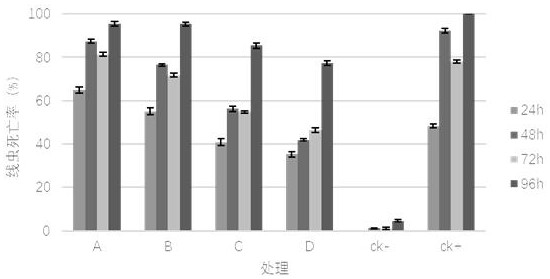Method and agent for preventing and treating cyst nematode disease of beet
A technology for cyst nematodes and nematode diseases, applied in the field of control methods and control agents for beet cyst nematode diseases, capable of solving problems such as high cost of control and treatment, toxic residues, and environmental pollution
- Summary
- Abstract
- Description
- Claims
- Application Information
AI Technical Summary
Problems solved by technology
Method used
Image
Examples
Embodiment 1
[0021] Take 100 g of soil infested by sugar beet cyst nematodes (hereinafter referred to as nematodes) and crush it, put it into a beaker, add water to soak the soil for 2-3 cm, and filter it with a 100-mesh filter after a large number of eggs float on the water surface, and use clean water to filter the soil The eggs were washed into the petri dish, sterilized by sodium hypochlorite for 3 min, washed with sterile water, and incubated in an incubator. Draw 50 microliters of nematode liquid (about 200 strips) into a 2 mL centrifuge tube, then add 1×10 10 , 2×10 8 , 1×10 8 , 5×10 7 Put 1.5 mL of Rhodospirillum rubrum at a concentration of cfu / ml into an incubator at 25 degrees Celsius and 60% relative humidity. The blank control uses sterile water, and the positive control uses abamectin. Each treatment is 30 strains, and the treatment is repeated. 3 times. Put them into an incubator at 25 degrees Celsius and 60% relative humidity, and observe the survival of nematodes unde...
Embodiment 2
[0023] The difference between embodiment 2 and embodiment 1 is that the photosynthetic bacteria used in embodiment 2 is Rhodopseudomonas palustris. In embodiment 2, different concentrations of Rhodopseudomonas palustris process the cyst nematode mortality statistics at different times as figure 2 shown.
[0024] From figure 1 and figure 2 It can be seen that different photosynthetic bacteria (Rhodospirillum rubrum and Rhodopseudomonas palustris) have certain lethal effects on cyst nematodes. Different concentrations of photosynthetic bacteria also had a certain lethal effect on cyst nematodes, and the higher the concentration, the better the lethal effect. The fatality rate gradually increased with the action time. When the concentration of photosynthetic bacteria reaches 2×10 8 When the simultaneous action time of more than cfu / ml reached 96 hours, the lethality of the two photosynthetic bacteria to cyst nematodes reached more than 90%, and the corrected mortality rat...
Embodiment 3
[0027] A concentration of 2×10 was selected on the basis of indoor toxicity assays 8 cfu / ml of Rhodospirillum rubrum for pot experiments. The beet seedlings were sown indoors and transplanted into sterile soil pots with a concentration of 2×10 8 The photosynthetic bacteria of cfu / ml carries out soaking treatment, and each pot seedling plants 1 sugar beet, and the inoculation concentration of each plant after transplanting is 2×10 8Cfu / ml of photosynthetic bacteria 2ml, with sterile water as a control, 1 day after transplanting, each beet plant was inoculated with 300 second-instar cyst nematodes, and each treatment was inoculated with 30 seedlings, repeated 3 times, placed in a greenhouse at 25°C, and exposed to light 14h / d culture. After 30 days of treatment, the plants were pulled out, and the cysts in the soil of each treatment were separated and counted by floating method. The cyst reduction rate was calculated according to the following formula: relative cyst inhibit...
PUM
 Login to View More
Login to View More Abstract
Description
Claims
Application Information
 Login to View More
Login to View More - Generate Ideas
- Intellectual Property
- Life Sciences
- Materials
- Tech Scout
- Unparalleled Data Quality
- Higher Quality Content
- 60% Fewer Hallucinations
Browse by: Latest US Patents, China's latest patents, Technical Efficacy Thesaurus, Application Domain, Technology Topic, Popular Technical Reports.
© 2025 PatSnap. All rights reserved.Legal|Privacy policy|Modern Slavery Act Transparency Statement|Sitemap|About US| Contact US: help@patsnap.com


